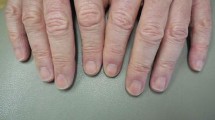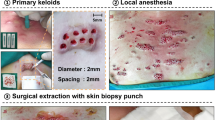Abstract
Aim
The treatment of foot ulcers with exposed bone is challenging, because of the risk of infection and of difficulties in the development of granulation tissue. A CO2 laser beam could be used to produce discontinuities in periosteum, allowing the exposure of blood containing multipotent stem cells, capable of initiating the healing process. The local application of platelet-rich plasma (PRP) has been proposed as a therapeutic tool for accelerating healing in foot ulcers, including those in patients with diabetes. Aim of the present pilot, proof-of-concept study is the assessment of the therapeutic potential of CO2 laser treatment, either alone or combined with PRP, in the treatment of diabetic foot ulcers with exposed bone.
Methods
We performed a pilot, uncontrolled 3-month observation study on a consecutive series of 9 type two diabetic patients and foot ulcers with exposed bone. A CO2-laser was used for producing nine discontinuities on periosteum for each cm2, by directing the focused laser beam on the bone until bleeding. The procedure was repeated up to 6 times, at a distance of 1 week and ulcers assessed weekly until the end of the study (3 months). In the last 5 of the 14 patients, the treatment described above was associated with PRP.
Results
Of the nine patients treated, four healed, and one more patient developed granulation tissue covering entirely bone surface. Out of the four patients who did not heal, one underwent minor amputation. Among the five patients treated with a combination of CO2 laser and PRP, two healed within 3 months, and two more patients developed granulation tissue covering entirely bone surface; the fifth patient did not show any improvement and underwent amputation.
Conclusions
The present pilot experience represents a novelty in this field showing a possible use of CO2-laser in the treatment of diabetic foot ulcers.

Similar content being viewed by others
References
Juri H, Palma JA (1987) CO2 laser in decubitus ulcers: a comparative study. Lasers Surg Med 7:296–299
Stellar S (1980) The carbon dioxide surgical laser in neurological surgery, decubitus ulcers, and burns. Lasers Surg Med 1:15–33
Krakowski AC, Diaz L, Admani S, Uebelhoer NS, Shumaker PR (2016) Healing of chronic wounds with adjunctive ablative fractional laser resurfacing in two pediatric patients. Lasers Surg Med 48(2):166–169
Phillips TJ, Morton LM, Uebelhoer NS, Dover JS (2015) Ablative fractional carbon dioxide laser in the treatment of chronic, posttraumatic, lower-extremity ulcers in elderly patients. JAMA Dermatol 151:868–871
Krakowski AC, Ghasri P (2015) Case report: rapidly healing epidermolysis bullosa wound after ablative fractional resurfacing. Pediatrics 135:e207–e210
Forney R, Mauro T (1999) Using lasers in diabetic wound healing. Diabetes Technol Ther 1:189–192
Marangoni O, Melato M (1998) Surgical cleansing of varicose ulcers of the leg using a CO2 laser with rotating mirror scanner. J Clin Laser Med Surg 16:181–184
Rinaldi F, Alberetto M, Pontiroli A (1993) The diabetic foot. General considerations and proposal of a new therapeutic and preventive approach. Diabetes Res Clin Pract 21:43–49
Chromey PA (1992) The efficacy of carbon dioxide laser surgery for adjunct ulcer therapy. Clin Podiatr Med Surg 9:709–719
Martinez-Zapata MJ, Martí-Carvajal AJ, Solà I, Expósito JA, Bolíbar I, Rodríguez L, Garcia J, Zaror C (2016) Autologous platelet-rich plasma for treating chronic wounds. Cochrane Database Syst Rev 5:CD006899
Armstrong DG, Lavery LA, Harkless LB (1998) Validation of a diabetic wound classification system. The contribution of depth, infection, and ischemia to risk of amputation. Diabetes Care 21:855–859
Pillon S, Bello C, Ceccarelli S, Boccuzzi L (2012) Wound Assessment EP 426 Telemedicine and wound management using dedicated smartphone app. Annual European Wound Management Association (poster), Wien
Apelqvist J, Bakker K, van Houtum WH, Nabuurs-Franssen MH, Schaper NC (2000). International consensus and practical guidelines on the management and the prevention of the diabetic foot. International Working Group on the Diabetic Foot. Diabetes Metab Res Rev 16(Suppl 1):S84–92.
Margolis DJ, Allen-Taylor L, Hoffstad O, Berlin JA (2003) Diabetic neuropathic foot ulcers: predicting which ones will not heal. Am J Med 115:627–631
Author contributions
Matteo Monami and Edoardo Mannucci wrote the manuscript and enrolled patients. Carlo Mirabella and Alesssia Scatena reviewed/edited the manuscript and contributed to the discussion. Stefania Zannoni contributed to the discussion and enrolled patients. Luca Giannoni and Sara Aleffi contributed to discussion, enrolled patients, and reviewed the manuscript. Matteo Monami is the guarantor of this work and, as such, had full access to all the data in the study and takes responsibility for the integrity of the data and the accuracy of the data analysis.
Author information
Authors and Affiliations
Corresponding author
Ethics declarations
Disclosure of potential conflicts of interest
The authors have no relevant conflict of interest to disclose.
Research involving human participants and/or animals, and Informed consent
Informed consent was obtained from all patients for being included in the study.
Funding
This research did not receive any specific grant from funding agencies in the public, commercial, or not-for-profit sectors.
Electronic supplementary material
Below is the link to the electronic supplementary material.
Rights and permissions
About this article
Cite this article
Monami, M., Mirabella, C., Scatena, A. et al. CO2 laser for the treatment of diabetic foot ulcers with exposed bone. A consecutive series of type 2 diabetic patients. J Endocrinol Invest 40, 819–822 (2017). https://doi.org/10.1007/s40618-017-0642-x
Received:
Accepted:
Published:
Issue Date:
DOI: https://doi.org/10.1007/s40618-017-0642-x




